History
 Cheerleaders are a staple of the sporting scene. Often seen at football games, they are also at other sporting event. Still, football is the main one, but how did cheerleading get started. It wasn’t some sort of organized decision by coaches or schools, but rather it was a spontaneous action that turned into something we all know about and enjoy watching, and something that many girls (and guys too) dream about becoming.
Cheerleaders are a staple of the sporting scene. Often seen at football games, they are also at other sporting event. Still, football is the main one, but how did cheerleading get started. It wasn’t some sort of organized decision by coaches or schools, but rather it was a spontaneous action that turned into something we all know about and enjoy watching, and something that many girls (and guys too) dream about becoming.
November 2, 1898, is officially recognized as the “birth of cheerleading.” It all started at the University of Minnesota, when student Johnny Campbell directed fans in cheering on the Golden Gophers football team, cheering “Rah, Rah, Rah! Ski-u-mah, Hoo-Rah! Hoo-Rah! Varsity! Varsity! Varsity, Minn-e-So-Tah!” That made Campbell the very first cheerleader. The whole thing was so well received, that soon after that, the University of Minnesota organized a “yell leader” squad of six male students, who still use Campbell’s original cheer today. Good thing the name “yell squad” didn’t take!! Prior to Campbell’s date with history, cheering existed, of course, just not in this new form. Prior to November 2, 1898, the fans  cheered at the game…meaning they yelled, screamed, and jumped up and down. Fans that would start cheers in the stands were called “cheerleaders,” on an unofficial basis, but they really weren’t officially leaders, just initiators. That day however, Campbell made history when he jumped down in front of the fans to lead an organized cheer.
cheered at the game…meaning they yelled, screamed, and jumped up and down. Fans that would start cheers in the stands were called “cheerleaders,” on an unofficial basis, but they really weren’t officially leaders, just initiators. That day however, Campbell made history when he jumped down in front of the fans to lead an organized cheer.
I don’t think everyone realizes just how important the cheerleaders are. Sometimes, when the game seems lost, the cheerleaders are solely responsible for lifting the spirits of fans and players alike. Sometimes, it encourages the players to press on, and other times it just tells them, “We love you anyway.” Today, most high school, college, and  professional sports teams have cheerleaders, with a few notable exceptions. The Cleveland Browns famously or infamously do not and never have had cheerleaders, and for this year neither do the Bills, Bears, Chargers, Giants, Packers, or Steelers. The Dallas Cowboy cheerleaders are probably one of the most famous of cheerleading organizations and for them it is a seriously big production. Tryouts are rigorous and highly competitive. The cheerleading squads these days are bigger than they used to be too. There are also competitions that are held each year too. It is now considered a sport in most schools. In fact, in the colleges, the cheerleaders have to sign a contract to be there and plan to stay with it for the entire season. Usually, there are scholarships attached to cheerleading, and the practice session and games are mandatory, with strict rules on allowed absences. Cheerleaders are an important aspect of college sports, and the squads must be dedicated. Cheerleading has come a long way since 1898, and I think most people would agree, that it’s been a good thing.
professional sports teams have cheerleaders, with a few notable exceptions. The Cleveland Browns famously or infamously do not and never have had cheerleaders, and for this year neither do the Bills, Bears, Chargers, Giants, Packers, or Steelers. The Dallas Cowboy cheerleaders are probably one of the most famous of cheerleading organizations and for them it is a seriously big production. Tryouts are rigorous and highly competitive. The cheerleading squads these days are bigger than they used to be too. There are also competitions that are held each year too. It is now considered a sport in most schools. In fact, in the colleges, the cheerleaders have to sign a contract to be there and plan to stay with it for the entire season. Usually, there are scholarships attached to cheerleading, and the practice session and games are mandatory, with strict rules on allowed absences. Cheerleaders are an important aspect of college sports, and the squads must be dedicated. Cheerleading has come a long way since 1898, and I think most people would agree, that it’s been a good thing.
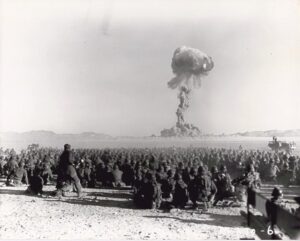
 Our government has been known, in its history, to do some things that really were underhanded, and in some cases horrific. The “need” for nuclear bombs naturally facilitated the need for nuclear testing. I think everyone knows that would had to have happened, but on November 1, 1951, the US Army conducted nuclear tests in the Nevada desert that included a “diabolical exercise in which 6500 US Army troops were exposed to the effects of a nearby nuclear detonation and its associated radiation.” When I read that, I was furious. They knew what they were doing, and they did it as an experiment…just to see what would happen to those poor men.
Our government has been known, in its history, to do some things that really were underhanded, and in some cases horrific. The “need” for nuclear bombs naturally facilitated the need for nuclear testing. I think everyone knows that would had to have happened, but on November 1, 1951, the US Army conducted nuclear tests in the Nevada desert that included a “diabolical exercise in which 6500 US Army troops were exposed to the effects of a nearby nuclear detonation and its associated radiation.” When I read that, I was furious. They knew what they were doing, and they did it as an experiment…just to see what would happen to those poor men.
It was called Operation Buster–Jangle. The US Army conducted a series of 7 nuclear tests, that included the November 1st test. In that involuntary one test, the 6500 troops, were dug in foxholes and trenches only 6 miles from an air burst nuclear bomb of 21 kilotons yield. That is about the size of the Nagasaki bomb!! After the soldiers felt the hot nuclear wind blast over them, the wind deposited desert dust in choking clouds upon the men. Then, the soldiers were ordered to get up and march across the blast site to within 900 meters (a little over ½ a mile) of the nuclear “ground zero.” That is incredibly close, and those men were exposed.
The damage done to those men was not well documented, but the US Government later passed the 1990 Radiation Exposure Compensation Act (RECA) to compensate the military veterans exposed to nuclear testing in the 1950’s. The passing of that act is implied acknowledgment of the responsibility of the US government in long term health problems experienced by those troops…without actually placing the blame, and therefore opening the government up to future lawsuits. Basically, the men, were they still alive, or their families, if not, 
 could theoretically be compensated for their losses. Of course, as many of us have seen with these kinds of cases, the process is very slow, the burden of proof for the men trying to receive compensation is heavy, and the final payout is usually quite low. RECA has awarded over $2.4 billion in benefits to more than 37,000 claimants since its inception in 1990. Still, that’s a small price to pay for the destruction of so many lives.
could theoretically be compensated for their losses. Of course, as many of us have seen with these kinds of cases, the process is very slow, the burden of proof for the men trying to receive compensation is heavy, and the final payout is usually quite low. RECA has awarded over $2.4 billion in benefits to more than 37,000 claimants since its inception in 1990. Still, that’s a small price to pay for the destruction of so many lives.
 During World War II, the Third Reich run by Adolf Hitler was at war with the world, but at that point, mostly with the British, and especially the British Royal Family. There were a number of bombing campaigns that devastated London, but it was the attack of September 13, 1940, that managed to hit the mark that Hitler would consider, the jackpot. That bombing managed to hit Buckingham Palace. upon hearing that, I wondered, “Where was the family?” Many people tried to leave London, if they had the means. Many of the children were hidden on the country. The rest of the people hid wherever they could…in places like subway tunnels and such. Pretty much everyone had their windows blacked out at night, so that unless there was a moon, homes were well hidden. That summer the German army ramped up their attacks on Britain. London was the prime target of the pounding by the Luftwaffe. Called “The Blitz” attacks, the bombings were very damaging…destroying much of London’s infrastructure.
During World War II, the Third Reich run by Adolf Hitler was at war with the world, but at that point, mostly with the British, and especially the British Royal Family. There were a number of bombing campaigns that devastated London, but it was the attack of September 13, 1940, that managed to hit the mark that Hitler would consider, the jackpot. That bombing managed to hit Buckingham Palace. upon hearing that, I wondered, “Where was the family?” Many people tried to leave London, if they had the means. Many of the children were hidden on the country. The rest of the people hid wherever they could…in places like subway tunnels and such. Pretty much everyone had their windows blacked out at night, so that unless there was a moon, homes were well hidden. That summer the German army ramped up their attacks on Britain. London was the prime target of the pounding by the Luftwaffe. Called “The Blitz” attacks, the bombings were very damaging…destroying much of London’s infrastructure.
Well, the Royal Family certainly had the means to get out, so I assumed that they were in Scottland or somewhere when all this took place. As the leaders of the country, it would certainly make sense to get them to  safety. Nevertheless, when Buckingham Palace was bombed on September 13, 1940, Queen Elizabeth and King George VI were there. On that morning they were relaxing with a cup of tea, when they heard the ‘unmistakable whirr-whirr of a German plane’ and the ‘scream of a bomb’ that was followed by a rumble and a crash. A German raider had dropped five high explosive bombs on the Palace. The areas hit were the Royal chapel, inner quadrangle, Palace gates, and the Victoria memorial. Four members of the Palace staff were injured, one of whom died. Thankfully, the King and Queen went unharmed in the incident. Queen Elizabeth said in a poignant statement, ‘I am glad we have been bombed. It makes me feel I can look the East-End in the face.’ I’m sure he was just trying to be brave, because they were obviously quite shaken up. Her stance strengthened the reputation of the Royal Family in the eyes of the British public.
safety. Nevertheless, when Buckingham Palace was bombed on September 13, 1940, Queen Elizabeth and King George VI were there. On that morning they were relaxing with a cup of tea, when they heard the ‘unmistakable whirr-whirr of a German plane’ and the ‘scream of a bomb’ that was followed by a rumble and a crash. A German raider had dropped five high explosive bombs on the Palace. The areas hit were the Royal chapel, inner quadrangle, Palace gates, and the Victoria memorial. Four members of the Palace staff were injured, one of whom died. Thankfully, the King and Queen went unharmed in the incident. Queen Elizabeth said in a poignant statement, ‘I am glad we have been bombed. It makes me feel I can look the East-End in the face.’ I’m sure he was just trying to be brave, because they were obviously quite shaken up. Her stance strengthened the reputation of the Royal Family in the eyes of the British public.
This wasn’t the first attempt to take out the palace. Days earlier, on September 8th, a 50-kilogram bomb fell on the grounds of the Palace. That one malfunctioned, and didn’t explode, so it was later destroyed in a controlled explosion. Of course, the British Foreign Office immediately recommended that the family should leave the country for a time after the second bomb did so much damage, they refused, and it was viewed as a deep 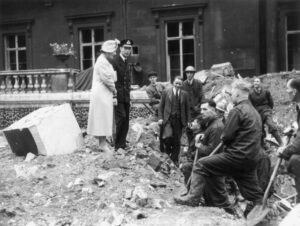 “courage and a commitment to the United Kingdom” that the public appreciated. The Queen went on to say that “The children will not leave unless I do. I shall not leave unless their father does, and the King will not leave the country in any circumstances, whatever. So, it was settled. This act of defiance in the face of the German Blitz gave the country a much-needed boost in their war efforts. The people felt like they were not alone, and they gained a sense of unity throughout the United Kingdom. All of this happened during the Battle of Britain, which began on July 10, 1940. I would say that the efforts were greatly increased, because it ended on October 31, 1940, with a British victory.
“courage and a commitment to the United Kingdom” that the public appreciated. The Queen went on to say that “The children will not leave unless I do. I shall not leave unless their father does, and the King will not leave the country in any circumstances, whatever. So, it was settled. This act of defiance in the face of the German Blitz gave the country a much-needed boost in their war efforts. The people felt like they were not alone, and they gained a sense of unity throughout the United Kingdom. All of this happened during the Battle of Britain, which began on July 10, 1940. I would say that the efforts were greatly increased, because it ended on October 31, 1940, with a British victory.
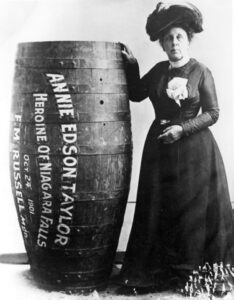
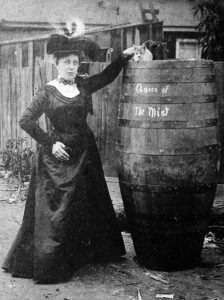 People have always been risk takers…always looking for that next thrill. Many people think that the biggest risk takers are the guys, but that is not always the case. On October 24, 1901, as a birthday gift to herself on her 63rd birthday, Anna “Annie” Edson Taylor, who was an American schoolteacher, became the first person to survive a trip over Niagara Falls in a barrel. Annie wasn’t just out to make a name for herself, but rather her motives were purely financial. Somehow, she thought this “claim to fame” would make her rich, but she never made much money from her adventure.
People have always been risk takers…always looking for that next thrill. Many people think that the biggest risk takers are the guys, but that is not always the case. On October 24, 1901, as a birthday gift to herself on her 63rd birthday, Anna “Annie” Edson Taylor, who was an American schoolteacher, became the first person to survive a trip over Niagara Falls in a barrel. Annie wasn’t just out to make a name for herself, but rather her motives were purely financial. Somehow, she thought this “claim to fame” would make her rich, but she never made much money from her adventure.
Annie was born on October 24, 1838, in Auburn, New York. She was one of eight children born to Merrick Edson and Lucretia Waring. Her father owned a flour mill and died when she was 12 years old, leaving enough money to provide a comfortable living for the family. Annie took a four-year training course, graduating with honors, and became a schoolteacher. While at college, she met David Taylor. They were married and had a son who died in infancy. Sadly, her husband died soon after. During her working years, the widowed Taylor, was often between jobs and locales.
Eventually, she moved to Bay City, Michigan, planning to become a dance instructor, except that there were no dance schools in Bay City at that time. No problem…Taylor opened her own. She moved to Sault Saint Marie in 1900 to teach music. From there, she traveled to San Antonio, Texas. Then she and a friend went to Mexico City to find work, but that venture completely failed, so she returned to Bay City. All of her moving and a number of other bad choices caused Taylor to find herself in hard times, Then, her house burned down, as well as a poor investment with a clergyman left her pretty broke. She claimed to be only 42 years old at the time and said that she could make money more easily if she were younger. Because she had always associated money and class with success, Taylor believed that she needed money to hold her place in the world. So, in the 1900 Federal Census, she declared her year of birth as 1860. She thought that if she was thought to be younger, she could make money easier.
Then, in what was most likely her craziest scheme ever, and hoping to secure her later years financially, Taylor decided she would be the first person to ride over Niagara Falls in a barrel. It seems that her money-making schemes were in endless supply. Taylor used a custom-made barrel constructed of oak and iron and padded with a mattress to make for her crazy trip. The barrel launch was delayed several times, mainly because no one wanted to be part of potential suicide. Finally, she decided she would have to do this on her own. First, two days before her own attempt, Taylor sent a domestic cat over the Horseshoe Falls in her barrel to test its strength to see if the barrel would break or not. Contrary to rumors at the time, the cat survived the plunge and seventeen minutes later, after she was found with a bleeding head, posed with Taylor in photographs. Then, on her 63rd birthday, the barrel was put over the side of a rowboat, and Taylor climbed in, carrying with her, her lucky heart-shaped pillow. The lid was screwed down, and friends used a bicycle tire pump to compress the air in the barrel. They plugged the hole used for the air with a cork, and Taylor was set adrift near the American shore, south of Goat Island.
The barrel was carried by river currents over the Canadian Horseshoe Falls, which has since been the site for all successful daredevil stunting at Niagara Falls. Shortly after her plunge, rescuers reached her barrel. Taylor was discovered to be alive and relatively uninjured, having received just a small gash on her head. The daring trip took less than twenty minutes, but it was some time before the barrel was actually opened. Taylor was helped out of the barrel by Carlisle Graham, her friend and the first man to run the rapids on a raft. After the journey, Taylor told the press, “If it was with my dying breath, I would caution anyone against attempting the feat … I would sooner walk up to the mouth of a cannon, knowing it was going to blow me to pieces than make another trip over the Fall.” Finally, she spoke some sense!! 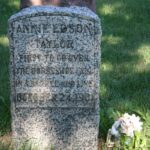
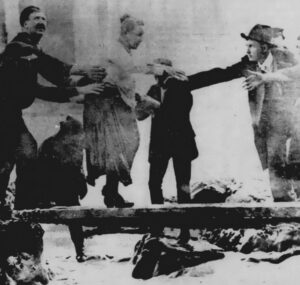
On February 23, 1921, Taylor was taken to the Niagara County Infirmary in Lockport, New York. Still lying about her age, she claimed to be 57. She died on April 29, 1921, aged 82 and was interred next to her friend and fellow daredevil Carlisle Graham, in the “Stunter’s Rest” section of Oakwood Cemetery in Niagara Falls, New York. Since she died penniless, public donations were collected to pay the costs of her funeral, which was held on May 5, 1921. She blamed her bad health and near blindness to her trip over the falls, twenty years earlier.
 When the Germans surrendered at the end of World War II, Germany was divided into four areas of control by the Allied Powers…Great Britain in the northwest, France in the southwest, the United States in the south, and the Soviet Union in the east. Berlin, the capital city situated in Soviet territory, was also divided into four occupied zones. That gave those four countries governing control over their own sections of Germany, and the people in those areas. Not every country was exactly planning to do what the people might consider to be their best interests. The Allied countries had the control and the ability to dish out punishment as they saw fit. The Soviet Union considered the forced labor of Germans as part of German war reparations for the damage inflicted by Nazi Germany on the Soviet Union during the Axis-Soviet campaigns (1941-1945) of World War II. They wanted to exact some measure of revenge, I guess, and they were in a position to make that happen.
When the Germans surrendered at the end of World War II, Germany was divided into four areas of control by the Allied Powers…Great Britain in the northwest, France in the southwest, the United States in the south, and the Soviet Union in the east. Berlin, the capital city situated in Soviet territory, was also divided into four occupied zones. That gave those four countries governing control over their own sections of Germany, and the people in those areas. Not every country was exactly planning to do what the people might consider to be their best interests. The Allied countries had the control and the ability to dish out punishment as they saw fit. The Soviet Union considered the forced labor of Germans as part of German war reparations for the damage inflicted by Nazi Germany on the Soviet Union during the Axis-Soviet campaigns (1941-1945) of World War II. They wanted to exact some measure of revenge, I guess, and they were in a position to make that happen.
So, the Soviet authorities deported German civilians from Germany and Eastern Europe to the USSR after World 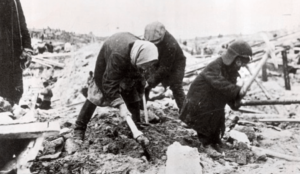 War II as forced laborers. It almost reminds me of what happened with the Holocaust, except that the Soviet Union had no interest in killing their captives. They wanted slave labor and a measure of retaliation. Ethnic Germans living in the USSR were conscripted for forced labor. German prisoners of war were also used as a source of forced labor during and after the war by the Soviet Union and by the Western Allies.
War II as forced laborers. It almost reminds me of what happened with the Holocaust, except that the Soviet Union had no interest in killing their captives. They wanted slave labor and a measure of retaliation. Ethnic Germans living in the USSR were conscripted for forced labor. German prisoners of war were also used as a source of forced labor during and after the war by the Soviet Union and by the Western Allies.
The decision was made and the fate of the German people was sealed. In 1946, the Soviet Union forcibly relocated more than 2,500 former Nazi German specialists, including scientists, engineers, and technicians who worked in specialist areas, from companies and institutions relevant to military and economic policy in the Soviet occupation zone of Germany (SBZ) and Berlin, along with around 4,000 family members, totaling more than 6,000 people, to the Soviet Union as war reparations. These specialists with all of their knowledge and abilities, could easily change the course of history in the Soviet Union, or any country they were placed in, for that matter. Still, not all of the forced labor were specialists. Many were unskilled labor, doing menial jobs.

The good thing was that the situation in Germany after World War II was appalling. Many of the people were homeless from the bombings. I suppose that, for that reason, the forced move, while scary, was not the worst thing in the world. It was possible that a new life in the Soviet Union could be favorable when compared to war-torn Germany. It is unclear whether any Germans who were sent to the Soviet Union chose to go back to Germany, because information about forced labor of Germans in the Soviet Union was suppressed in the Eastern Bloc until after the dissolution of the Soviet Union in 1991. Many of those records could have also been destroyed.
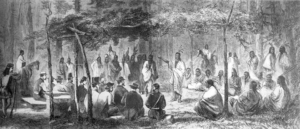 Actually, The Medicine Lodge Treaty is the name given for three treaties that were signed near Medicine Lodge, Kansas, between the Federal government of the United States and southern Plains Indian tribes on October 21, 1867. The treaties were intended to bring peace to the area by relocating the Native Americans to reservations in Indian Territory and away from European-American settlement. The Indian Peace Commission had concluded in its final report in 1868, that the wars were completely preventable. The commission determined that the United States government and its representatives, including the United States Congress, had contributed to the warfare on the Great Plains by failing to fulfill their legal obligations and to treat the Native Americans with honesty. This fact is not a new concept for anyone who has studied history at all.
Actually, The Medicine Lodge Treaty is the name given for three treaties that were signed near Medicine Lodge, Kansas, between the Federal government of the United States and southern Plains Indian tribes on October 21, 1867. The treaties were intended to bring peace to the area by relocating the Native Americans to reservations in Indian Territory and away from European-American settlement. The Indian Peace Commission had concluded in its final report in 1868, that the wars were completely preventable. The commission determined that the United States government and its representatives, including the United States Congress, had contributed to the warfare on the Great Plains by failing to fulfill their legal obligations and to treat the Native Americans with honesty. This fact is not a new concept for anyone who has studied history at all.
At the request of the tribal chiefs, the US government met the chiefs at a place traditional for Native American ceremonies. The first treaty was signed October 21, 1867, with the Kiowa and Comanche tribes. The second, with the Kiowa-Apache, was signed the same day. The third treaty was signed with the Southern Cheyenne and Arapaho on October 28, 1867. 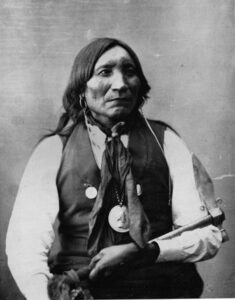
As expected, the Medicine Lodge Treaty, heavily favored the Congress and the white settlers. The tribes were assigned reservations of diminished size compared to the territories that had been defined in an 1865 treaty. The treaty tribes never actually ratified the treaty by vote of adult males…a requirement of the tribes. The Congress also changed the allotment policy under the Dawes Act and authorized sales under the Agreement with the Cheyenne and Arapaho (1890) and the Agreement with the Comanche, Kiowa and Apache (1892). With the agreement, signed with the Cherokee Commission, the Congress further reduced the reservation territory promised to the Indians. Lone Wolf, the Kiowa chief, immediately filed a lawsuit against the government for fraud on behalf of the tribes in Lone Wolf v. Hitchcock. The US Supreme Court ruled against the tribes in 1903, after determining that the Congress had “plenary power” and the political right to make such decisions. With the power of that decision to back them, Congress wasted no time in unilaterally acting in the same manner on land decisions related to other reservations as well.
Because of the outstanding issues with the treaty and subsequent government actions, in the mid-20th century, the Kiowa, Arapaho and Comanche filed several suits for claims against the US government. Over decades, they won substantial settlements of monetary compensation in the amount of tens of millions of dollars, although it 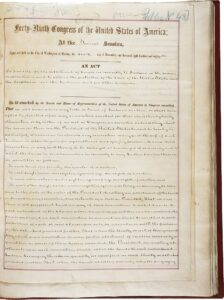
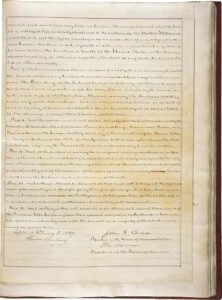 took years for the cases to be resolved.
took years for the cases to be resolved.
I don’t know what could have been done differently, exactly, other than to be completely fair with our treatment of the Indians. I have never liked the idea of forcing them to be on the reservations. The land they were given was far less than they should have received, and instead of letting them become members of society, where they could make an honest living, they were given compensation without the need to earn in, creating a group of people who could make no contribution to society at all. It basically took away their self-respect and their sense of worth…a situation which helped no one. The fighting continued until the last battle was fought on January 9, 1918.
 People in our modern-day world truly take some of history’s inventions for granted. Things that have been around for a long time, are especially susceptible. Around 3000 BC, the Egyptians used early concrete forms as mortar in their construction work. The Great Pyramids at Giza were built from an early form of concrete, and they are still standing today. It seems strange to think of concrete existing way back then, but it actually did. It might not have been in exactly the same form as the concrete of today. In fact, the Bible tells of using clay and straw to make bricks and mortar. It seems rather archaic to us these days, and but then it seems to have lasted a whole lot longer than some of the concrete of today, so maybe some of it was better.
People in our modern-day world truly take some of history’s inventions for granted. Things that have been around for a long time, are especially susceptible. Around 3000 BC, the Egyptians used early concrete forms as mortar in their construction work. The Great Pyramids at Giza were built from an early form of concrete, and they are still standing today. It seems strange to think of concrete existing way back then, but it actually did. It might not have been in exactly the same form as the concrete of today. In fact, the Bible tells of using clay and straw to make bricks and mortar. It seems rather archaic to us these days, and but then it seems to have lasted a whole lot longer than some of the concrete of today, so maybe some of it was better.
Portland cement was invented by Joseph Aspdin of England in 1824. The first concrete  paved street in the United States was laid in Bellefontaine, Ohio in 1891. The street was paved by George W Bartholomew, who owned the Buckeye Portland Cement Company and convinced city officials to let him pave an eight-foot-wide strip of Main Street with a mixture of sand, stone, and cement. Two years later, city officials agreed to let Bartholomew pave an entire block of Court Avenue between Main Street and Opera Street, which today remains the oldest concrete street in America, and it still exists, unlike some of the products currently used for streets today.
paved street in the United States was laid in Bellefontaine, Ohio in 1891. The street was paved by George W Bartholomew, who owned the Buckeye Portland Cement Company and convinced city officials to let him pave an eight-foot-wide strip of Main Street with a mixture of sand, stone, and cement. Two years later, city officials agreed to let Bartholomew pave an entire block of Court Avenue between Main Street and Opera Street, which today remains the oldest concrete street in America, and it still exists, unlike some of the products currently used for streets today.
Steel-reinforced concrete was developed by the end of the 19th century. August Perret designed and built an apartment building in Paris using steel-reinforced concrete in 1902. The building was widely admired, and with that building came a new popularity for concrete. In fact, the building influenced further development of reinforced concrete. Eugène Freyssinet really pioneered reinforced-concrete construction by building two colossal parabolic-arched airship hangars at Orly Airport in Paris in 1921.
Concrete has undergone several changes since 1921. During the 21st century, concrete manufacturers have  sstarted changing many of their product formulas in ways that increase early strength and lessen later age trength. This threw me a little bit, but the primary reason for this shift is said to be practical…”On a construction site, you can remove the forms from new concrete much faster if it has high early strength 1. Additionally, according to AZoBuild.com, concrete has gone through numerous changes over the last few decades despite its appearance looking almost the same. These changes include the development of environmentally friendly concrete products.” I’m not sure these changes are all that good, because they seem to cause more cracking and an earlier breakdown of the concrete. I’m not a contractor, but that doesn’t seem like a good thing to me.
sstarted changing many of their product formulas in ways that increase early strength and lessen later age trength. This threw me a little bit, but the primary reason for this shift is said to be practical…”On a construction site, you can remove the forms from new concrete much faster if it has high early strength 1. Additionally, according to AZoBuild.com, concrete has gone through numerous changes over the last few decades despite its appearance looking almost the same. These changes include the development of environmentally friendly concrete products.” I’m not sure these changes are all that good, because they seem to cause more cracking and an earlier breakdown of the concrete. I’m not a contractor, but that doesn’t seem like a good thing to me.
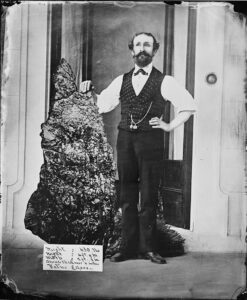 Bernhardt Otto Holtermann, who was born on April 29, 1838, was a prospector who owned part of an Australian claim where rich veins of gold were discovered after years of dry digging. I suppose it does take perseverance to successfully mine for gold, but when you consider that Holtermann finally discovered gold afteryears of digging, I would say that mining for gold also takes faith. Holtermann was born in Germany, and at adulthood set sail for Sydney, Australia in order to avoid military service. Most of his mining years were unsuccessful, including the year he even blew himself up with a premature explosion of blasting powder. Of course, his accidental explosion did not kill him, and must not have been very strong, because at the time of his greatest find, he still had all his limbs.
Bernhardt Otto Holtermann, who was born on April 29, 1838, was a prospector who owned part of an Australian claim where rich veins of gold were discovered after years of dry digging. I suppose it does take perseverance to successfully mine for gold, but when you consider that Holtermann finally discovered gold afteryears of digging, I would say that mining for gold also takes faith. Holtermann was born in Germany, and at adulthood set sail for Sydney, Australia in order to avoid military service. Most of his mining years were unsuccessful, including the year he even blew himself up with a premature explosion of blasting powder. Of course, his accidental explosion did not kill him, and must not have been very strong, because at the time of his greatest find, he still had all his limbs.
Holtermann’s “claim to fame” gold nugget was the largest gold specimen ever found, 59 inches long, weighing 630 pounds, and with an estimated gold content of 3,000 troy ounces. It was found at Hill End, near Bathurst, New South Wales. The nugget brought him enough wealth to build a mansion in North Sydney. Today, the mansion is one of the boarding houses at Sydney Church of England Grammar School (known as the Shore school). While working with one of his partners and later brother-in-law, Ludwig Hugo ‘Louis’ Beyers in their Star of Hope Gold Mining Company, in which he and Beyers were among the partners, they struck it rich. On February 22, 1868, Holtermann married Harriett Emmett, while Beyers married her sister Mary. On October 19, 1872, the Holtermann Nugget was discovered. While it was not “strictly speaking” a nugget, it was a gold specimen, a mass of gold embedded in rock, in this case quartz. Holtermann attempted to buy the 3,000-troy-ounce specimen from the company, offering £1000 over its estimated value of £12,000 (about AU$1.9 million in 2016 currency, AU$4.8 million on the 2017 gold price), 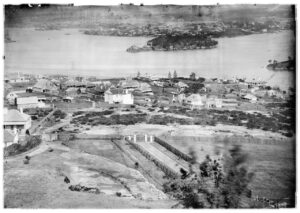 but was turned down, and the nugget was sent away to have the gold extracted. Holtermann was so upset about that, that resigned from the company in February 1873.
but was turned down, and the nugget was sent away to have the gold extracted. Holtermann was so upset about that, that resigned from the company in February 1873.
Holtermann did manage to get a photograph of himself with the nugget. This famous photo of Holtermann next to a giant “nugget” was taken by an unknown photographer. After leaving the Star of Hope Gold Mining Company, Holtermann was elected as a member for Saint Leonard’s parliament in 1882. Tragically, at the young age of just 47 years, Holtermann died in Sydney, Australia on his birthday, April 29, 1885, of “cancer of the stomach, cirrhosis of the liver, and dropsy.” He left behind his wife, three sons, and two daughters.
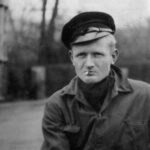 Bent Faurschou Hviid, who was born January 7, 1921, later became a member of the Danish resistance group Holger Danske during World War II. Because of his red hair, Hviid was nicknamed “Flammen,” which means “The Flame.” In 1951, he and his Resistance partner Jørgen Haagen Schmith, were posthumously awarded the United States Medal of Freedom by President Harry Truman. The Presidential Medal of Freedom is the highest civilian award of the United States, alongside the Congressional Gold Medal. The award is not limited to US citizens and, while it is a civilian award, it can also be awarded to military personnel and worn on the uniform.
Bent Faurschou Hviid, who was born January 7, 1921, later became a member of the Danish resistance group Holger Danske during World War II. Because of his red hair, Hviid was nicknamed “Flammen,” which means “The Flame.” In 1951, he and his Resistance partner Jørgen Haagen Schmith, were posthumously awarded the United States Medal of Freedom by President Harry Truman. The Presidential Medal of Freedom is the highest civilian award of the United States, alongside the Congressional Gold Medal. The award is not limited to US citizens and, while it is a civilian award, it can also be awarded to military personnel and worn on the uniform.
If you were to ask the men who were a part of the Holger Danske, they would tell you that no other resistance member was as hated or sought after by the Germans as was Hviid. Leader of the Holger Danske from 1943 through 1945, Gunnar Dyrberg said in the 2003 Danish documentary film, “With a Right to Kill,” that no one knows exactly how many executions “The Flame” performed, but he was rumored to have killed 22 persons. In all, it is said that the Holger Danske carried out an estimated 400 executions…performed by the Resistance agents, but apparently no one man executed more than Hviid.
Hviid grew up during World War I and was 20 when the Germans occupied Denmark. He was not about to just sit back and let the Nazis take over his country…at least, not without a fight. He entered the Holger Danske resistance group in Copenhagen. He was assigned to kill Danish Nazi officials and collaborators…traitors, who in Hviid’s opinion, did not deserve to live.
“Flammen” often partnered with “Citronen” whose real name was Jørgen Haagen Schmith. “Citronen” means “the lemon.” Schmith got this nickname because he sabotaged a Citroën garage, destroying six German cars and a tank. Citronen usually drove for Flammen, who executed their given targets. The two men were the most famous resistance duo in Denmark during World War II. While they often worked together, the Germans put the highest bounty on Flammen’s head that they offered for any Resistance fighter, due to the Faurschou of Germans who were executed by Flammen.
On October 18, 1944, while Hviid was having dinner with his landlady and some other guests, someone knocked at the door. When the door was opened, a German officer demanded entry. Hviid, who was unarmed  that evening, quickly went upstairs seeking to escape across the roof. When he reached the roof, he saw that the house was surrounded. Refusing to be taken alive, Hviid chewed a cyanide capsule and was dead a few seconds later.
that evening, quickly went upstairs seeking to escape across the roof. When he reached the roof, he saw that the house was surrounded. Refusing to be taken alive, Hviid chewed a cyanide capsule and was dead a few seconds later.
The witnesses later told of how they could hear the German soldiers upstairs cheering at the sight of the corpse. For the Germans, the form of death that took “The Flammen” out made no difference to the German soldiers. All that mattered was that he was dead. The soldiers dragged Hviid downstairs feet first, repeatedly causing his head to bang against the stairs as they went. I suppose it was a show of disrespect or perhaps, triumph for them, although they did not cause his death really.
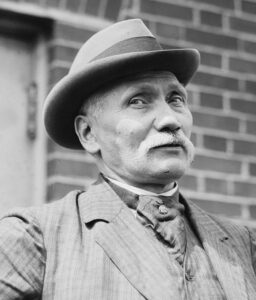
 Sometimes, you come across someone so bold and so outrageous in their actions, that you are left in complete shock. Now, I can’t say that I am the one in complete shock, but I suspect that a squad of German soldiers might have been, when on October 17, 1906, Wilhelm Voigt, a 57-year-old German shoemaker, decided to impersonate an army officer and lead an entire squad of soldiers to help him steal 4,000 marks. When calculated to American dollars and to 2023, that would be approximately $33,000. While Voigt was a shoemaker by trade, he also had a long criminal record as a thief. So, he carefully planned the robbery, knowing that the German soldiers had a long history of blind obedience.
Sometimes, you come across someone so bold and so outrageous in their actions, that you are left in complete shock. Now, I can’t say that I am the one in complete shock, but I suspect that a squad of German soldiers might have been, when on October 17, 1906, Wilhelm Voigt, a 57-year-old German shoemaker, decided to impersonate an army officer and lead an entire squad of soldiers to help him steal 4,000 marks. When calculated to American dollars and to 2023, that would be approximately $33,000. While Voigt was a shoemaker by trade, he also had a long criminal record as a thief. So, he carefully planned the robbery, knowing that the German soldiers had a long history of blind obedience.
Voigt got his hands on a captain’s uniform and hatched a plan to manipulate the German army into following his lead, thereby exploiting their blind obedience to authority and making them assist in his crazy robbery scheme. Voigt approached a troop of soldiers in Tegel, Germany. Just outside Berlin, he boldly ordered the unit to follow him 20 miles into the town of Kopenik. The group had lunch, and then Voigt put the men in position and stormed into the mayor’s office. They proceeded to arrest the mayor. He demanded to see the cash box and 
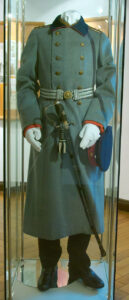 confiscated the 4,000 marks inside. The mayor was put in a car, and Voigt ordered that he be delivered to the police in Berlin. Just like that, the mayor was under arrest…by an imposter.
confiscated the 4,000 marks inside. The mayor was put in a car, and Voigt ordered that he be delivered to the police in Berlin. Just like that, the mayor was under arrest…by an imposter.
And the misfit squad of soldiers proceeded to Berlin, Voigt managed to disappear with the money. No one noticed that he had gone, and it took more than a few hours at the police station before everyone realized that it was all a hoax. As for the Kaiser…well, he thought the story was funny, but They had been humiliated by the man who was obviously impersonating a captain. They launched a massive campaign to find Voigt. They wanted revenge for the fact that they were fooled. Voigt was caught in Berlin a few days later. Voigt was found guilty and was sentenced to four years for the robbery. Somehow, the Kaiser himself pulled some strings to get him out in less than two. While he was a convicted criminal after that, the people considered him a bit of a hero for the rest of his life. He even posed for pictures for years. His little ruse, while considered a crime by the Germans, made Voigt famous.

